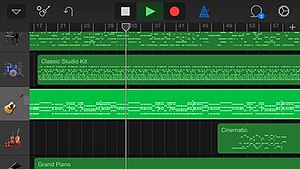Apple GarageBand
 |
|

GarageBand 10.0.3 on OS X Mavericks
|
|
| Developer(s) | Apple Inc. |
|---|---|
| Initial release | January 6, 2004 |
| Stable release |
10.2 / June 5, 2017
|
| Operating system | macOS |
| Type | Digital audio workstation |
| Website | www.apple.com/mac/garageband |

GarageBand for iOS
|
|
| Developer(s) | Apple Inc. |
|---|---|
| Stable release |
2.2.2 / June 5, 2017
|
| Operating system | iOS |
| Type | Digital audio workstation |
| License | Proprietary |
| Website | www.apple.com/ios/garageband |
GarageBand is a line of digital audio workstations for macOS and iOS that allows users to create music or podcasts. GarageBand is developed and sold by Apple Inc. for macOS, and is part of the iLife software suite. Its music and podcast creation system enables users to create multiple tracks with pre-made MIDI keyboards, pre-made loops, an array of various instrumental effects, and voice recordings.
GarageBand was developed by Apple under the direction of Dr. Gerhard Lengeling. Dr. Lengeling was formerly from the German company Emagic, makers of Logic Audio. (Apple acquired Emagic in July 2002.)
Steve Jobs announced the application in his keynote speech at the Macworld Conference & Expo in San Francisco on January 6, 2004. The musician John Mayer assisted with its demonstration.
Apple announced GarageBand 2 at the 2005 Macworld Conference & Expo on January 11, 2005. It shipped, as announced, around January 22, 2005. Notable new features included the abilities to view and edit music in musical notation. It was also possible to record up to 8 tracks at once and to fix timing and pitch of recordings. Apple added automation of track pan position, master volume, and the master pitch. Transposition of both audio and MIDI has been added by Apple along with the ability to import MIDI files.
GarageBand 3, announced at 2006’s Macworld Conference & Expo, includes a 'podcast studio', including the ability to use more than 200 effects and jingles, and integration with iChat for remote interviews.
...
Wikipedia
